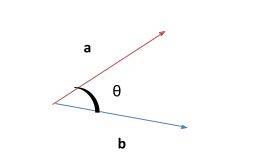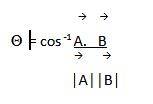
Rachit Kumar SaxenaManager-Editorial
Angle Between Two Vectors
A quantity that has magnitude, as well as direction, is called a vector. However, scalar quantities have a magnitude and no direction. A vector can be represented in two forms, i.e., in two dimensions and three dimensions.
How to find an angle between two vectors?
To find the angle between two vectors, one needs to follow the below steps:
Step 1 – Estimate the dot product of the given vectors with the use of the following formula:
→ →
A. B = AxBx + AyBy + AzBz
Step 2 – Calculate the magnitude of both the numbers separately. The method to calculate the magnitude is squaring all the vectors’ components and adding them together and finding the result’s square roots.
Step 3 – The last step would be substituting the values of the dot product and the magnitude of both the vectors, i.e.
Importance of Angle Between two Vectors
The Vector Algebra chapter in the NCERT Class XII Maths includes some key topics such as:
- Vectors and scalars (direction and magnitude of a vector)
- Direction cosines and ratios of a vector
- The position vector of a point dividing a line segment in a given ratio
- Properties and application of scalar product of vectors (dot), vector product of vectors (cross), and scalar triple product of vectors
Weightage of the Topic
The angle between the two vectors is an essential topic in class XII. The chapter Vectors carries 12 marks in Final Examination. Students may expect around 2-4 marks questions from this topic.
Illustrative Examples on Angle Between two Vectors
Some of the examples of angle between two vectors are as below:
1. Calculate the angle between two vectors 3i + 4j and 2i – j + k
Solution.
→ →
a = 3i + 4j – k and b = 2i – j + k
The dot product is defined as:
→ →
a . b = (3i + 4j – k).(2i – j + k)
= (3)(2) + (4)(-1) + (-1)(1)
=6-4-1
=1
→ →
Thus, a . b = 1
The magnitude of vectors is given as below:
→
│a│= √(32 + 42 + (-1)2) = √26 = 5.09
→
│b│= √(22 + (-1)2 + 12) = √6 = 2.45
The angle between the two vectors is as follows:
→ →
= cos-1 A. B
→ →
│A││B│
=cos-1 1 /(5.09)(2.45)
= cos-1 1/12.47
= cos-1 (0.0802)
= 85.39°
2. Compute the angle between two vectors 5i - j + k and i + j - k
Solution.
→ →
a = 5i - j + k and b = i + j - k
The dot product is defined as:
→ →
a . b = (5i - j + k)(i + j - k)
= (5)(1) + (-1)(1) + (1)(-1)
=5-1-1
=3
→ →
Thus, a . b = 1
The magnitude of vectors is given as below:
→
│a│= √(52 + (-1)2 + 12) = √27 = 5.19
→
│b│= √(12 + 12 + (-1)2) = √3 = 1.73
The angle between the two vectors is as follows:
→ →
= cos-1A. B
→ →
│A││B│
= cos-1 3 /(5.19)(1.73)
= cos-1 3 / 8.97
= cos-1 (0.334)
= 70.48°
FAQs on Angle Between Two Vectors
Q: What are the different types of vectors?
Q: Which are the major topics covered in Class XII Maths Chapter 10 in the NCERT syllabus?
Q: What is the difference between vector and scalar?
Q: What will the students learn from the 10th Chapter of Class XII of NCERT syllabus?
Q: What is equality of vectors?
News & Updates
Vector Algebra Exam
Student Forum
Popular Courses After 12th
Exams: BHU UET | KUK Entrance Exam | JMI Entrance Exam
Bachelor of Design in Animation (BDes)
Exams: UCEED | NIFT Entrance Exam | NID Entrance Exam
BA LLB (Bachelor of Arts + Bachelor of Laws)
Exams: CLAT | AILET | LSAT India
Bachelor of Journalism & Mass Communication (BJMC)
Exams: LUACMAT | SRMHCAT | GD Goenka Test

